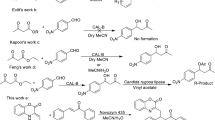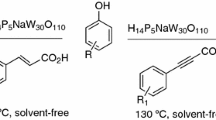Abstract
A chlorogenate hydrolase (EC 3.1.1.42) synthesized 2-phenylethyl caffeate (2-CAPE) from 5-chlorogenic acid (5-CQA) and 2-phenylethyl alcohol (2-PA) (by transesterification), from 5-CQA and 2-phenylethyl bromide (2-PBr) (by substitution of bromine), and from caffeic acid (CA) and 2-PA or 2-PBr (by condensation) as well as hydrolysis of 5-CQA. Some reaction conditions including pH, temperature, substrate and solvent concentrates, and reaction time were optimized for the production of 2-CAPE. A maximal molar yield of 50% was achieved by transesterification, 4.7% by substitution of bromine, and 13% by condensation. Among the parameters studied for optimization, the pH of the buffer solution and concentration of 2-PA or 2-PBr affected the production of 2-CAPE. The optimum pH for the hydrolysis reaction was within the neutral range (pH 6.5), whereas the residual three reactions were only catalyzed within the acidic range (pH 3.0–4.0). The optimum concentrations of 2-PA and 2-PBr for three reactions were 5–70 vol% and no 2-CAPE was produced in the 2-PA or 2-PBr solutions containing powdered enzyme. The enzyme may bind to the caffeoyl moiety of 5-CQA or CA to form an enzyme–substrate complex. It then catalyzes four different reactions corresponding to the reaction conditions.





Similar content being viewed by others
References
Athawale V, Manjrekar N, Athawale M (2003) Effect of reaction parameters on synthesis of citronellyl methacrylate by lipase-catalyzed transesterification. Biotech Prog 19:298–302
Chang WC, Hsu FL (1992) Inhibition of platelet activation and endothelical cell injury by polyphenolic compounds isolated from Lonicera Japonica Thunb, Prost. Leuk. Essen. Fatty Acids 45:307–312
Hatzakis NS, Daphnomili D, Smonou I (2003) Ferulic acid esterase from Humicola Insolens catalyzes enanthioselective transesterification of secondary alcohols. J Mol Catal B: Enzym 21:309–311
Kobayashi T, Adachi S, Matsuno R (2003) Lipase-catalyzed condensation of p-methoxyphenethyl alcohol and carboxylic acids with different steric and electrical properties in acetonitrile. Biotechnol Lett 25:3–7
Na HK, Wilson MR, Kang KS, Chang CC, Grunberger D, Trosko JE (2000) Restoration of gap junctional intercellular communication by caffeic acid phenetyl ester (CAPE) in a ras-transformed rat liver epithelial cell line. Cancer Lett 157:31–38
Okamura S, Watanabe M (1982) Purification and properties of hydroxycinnamic acid ester hydrolase from Aspergillus japonicus. Agric Biol Chem 46:1839–1848
Schobel B (1980) Isolation and characterization of a chlorogenic acid esterase from Aspergillus niger. Z Naturforsch 35c:209–212
Schobel B, Pollmann W (1980) Further characterization of a chlorogenic acid hydrolase from Aspergillus niger. Z Naturforsch 35c:699–701
Stamatis H, Sereti V, Kolisis FN (2001) Enzymatic synthesis of hydrophilic and hydrophobic derivatives of natural phenolic acids in organic media. J Mol Catal B Enzymol 11:323–328
Tagashira M, Ohtake Y (1998) A new antioxidative 1,3-benzodioxole from Melissa officinalis. Planta Med 64:555–558
Ysrael MC, Nonato MG (1999) Biological activities of chemical constituents from Ipomoea muricata [Jacq]. Convolvulaceae. Acta Manilana Ser A 47:41–52
Acknowledgements
We are grateful to Dr Masanori Morita and Dr Toshie Minematsu at the Joint Research Centre of Kinki University for the mass and NMR analyses of the caffeic acid esters.
Author information
Authors and Affiliations
Corresponding author
Rights and permissions
About this article
Cite this article
Kishimoto, N., Kakino, Y., Iwai, K. et al. Chlorogenate hydrolase-catalyzed synthesis of hydroxycinnamic acid ester derivatives by transesterification, substitution of bromine, and condensation reactions. Appl Microbiol Biotechnol 68, 198–202 (2005). https://doi.org/10.1007/s00253-004-1876-z
Received:
Revised:
Accepted:
Published:
Issue Date:
DOI: https://doi.org/10.1007/s00253-004-1876-z




